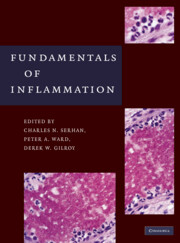Book contents
- Frontmatter
- Contents
- Contributors
- Preface
- PART I THE INFLAMMATORY RESPONSE – AN OVERVIEW
- PART II INDIVIDUAL CELL TYPES
- PART III CHEMICAL MEDIATORS
- 12 Lipid Mediators in Acute Inflammation and Resolution: Eicosanoids, PAF, Resolvins, and Protectins
- 13 Cytokines and Chemokines in Inflammation
- 14 Adenosine Receptors: Therapeutic Aspects for Inflammatory and Immune Diseases
- 15 Leukocyte Generation of Reactive Oxygen Species
- 16 Cell Adhesion Molecules
- PART IV IMMUNOPHARMACOLOGY
- PART V INFLAMMATORY DISEASES/HISTOLOGY
- PART VI ANIMAL MODELS OF INFLAMMATION
- Index
- References
15 - Leukocyte Generation of Reactive Oxygen Species
from PART III - CHEMICAL MEDIATORS
Published online by Cambridge University Press: 05 April 2014
- Frontmatter
- Contents
- Contributors
- Preface
- PART I THE INFLAMMATORY RESPONSE – AN OVERVIEW
- PART II INDIVIDUAL CELL TYPES
- PART III CHEMICAL MEDIATORS
- 12 Lipid Mediators in Acute Inflammation and Resolution: Eicosanoids, PAF, Resolvins, and Protectins
- 13 Cytokines and Chemokines in Inflammation
- 14 Adenosine Receptors: Therapeutic Aspects for Inflammatory and Immune Diseases
- 15 Leukocyte Generation of Reactive Oxygen Species
- 16 Cell Adhesion Molecules
- PART IV IMMUNOPHARMACOLOGY
- PART V INFLAMMATORY DISEASES/HISTOLOGY
- PART VI ANIMAL MODELS OF INFLAMMATION
- Index
- References
Summary
INTRODUCTION
The rapid response of the innate immune system of humans depends in large part on the behavior of a subset of leukocytes known as polymorphonuclear leukocytes or neutrophils. Constituting the majority of white blood cells in the circulation, neutrophils provide continuous surveillance for microbial and noninfectious threats to the integrity of the host. Once recruited to an area of infection, neutrophils ingest microbes and thereby confine them in the phagosome, a membrane-bound compartment where an array of antibacterial factors can be delivered to kill and degrade the trapped microorganism. In addition to proteins that exhibit direct antimicrobial action, cytoplasmic granules in neutrophils contain enzymes that utilize microbial constituents as substrate, thereby compromising the structural integrity of the organism and indirectly contributing to microbial killing. Under normal circumstances, these complex and synergistic events occur in the presence of reactive oxygen species (ROS) generated in situ by activation of a multicomponent enzyme, the phagocyte NADPHdependent oxidase. Like the prefabricated granule constituents, ROS damage targets directly and act in concert with granule proteins to generate second derivative active agents. The concomitant release of granule proteins and activation of the NADPH oxidase thus provide phagocytic cells such as neutrophils with the capacity to respond rapidly to potentially life-threatening challenges and thus provide the initial wave of host defense.
- Type
- Chapter
- Information
- Fundamentals of Inflammation , pp. 198 - 207Publisher: Cambridge University PressPrint publication year: 2010



